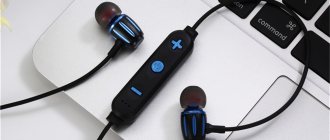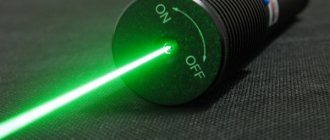Listening to music through headphones is very convenient. This does not create discomfort for others and allows you to fully enjoy your favorite compositions. This is why many people use music while walking or playing sports. In this hobby, young people are quickly catching up with older people.
The active use of headphones has led to numerous studies of their effect on the body. Many experts argue that this method of listening to audio recordings causes irreparable harm to human hearing.
Reasons for the negative impact of headphones
Listening to music through speakers, speakers or other devices does not pose a threat, since the sound penetrates the auricle, which is a natural resonator. Therefore, sound waves undergo the necessary amplification and regulation. The harmful effects of headphones do not lie in the placement of a foreign object in the ears, but in the negative consequences of the direct transmission of sound.
While listening to music, the organ’s protection mechanism against sound attacks is triggered. A person is caught in an irreversible process of change and death of most of the membrane and hair cells that cover the so-called cochlea (inner ear). This may cause hearing loss.
Researchers agree that hearing loss is not caused by using headphones, but by listening to music too loudly. In just a century, the disease has become seriously younger - its limits have decreased from 70 to 40 years. Doctors say one of the main reasons is the habit of constantly listening to audio files in popular gadgets.
The volume level in the device is proportional to the amount of damage caused to hearing. Increasing the volume level leads to an increase in pressure and energy transmitted by the sound wave. The hearing organs function at their limit and slowly wear out.
Gradual wear and tear of the internal auditory organ cannot be treated. At the initial stage, treatment with medication is possible, but, as a rule, its effect is limited to 72 hours. The solution to extreme cases is only a hearing aid.
Is bone conduction sound harmful? Who needs these headphones?
I have already devoted more than one article to the remarkable phenomenon of bone sound conduction, or rather to the technology that uses this phenomenon. You can read about the history and essence of the phenomenon here, and detailed reviews of Trekz Titanium and Trekz Air - headphones from Aftershokz - shed even more light on what is happening. It would seem, what else can be added? I enthusiastically love “bone conduction”, I consider it a useful and convenient feature and I strongly recommend that readers familiarize themselves with it. However, like everything new and unfamiliar, bone conduction excites people’s thoughts (including mine): isn’t it harmful? Not dangerous? Will I lose my hearing after a couple of years of using these headphones?
The inherent xenophobia of a human being whispers venomously: “how dangerous! Just look, your ears will fall off!” And intuition, coupled with common sense, suggests that there is nothing to worry about. However, modern science does not make friends with abstract “common sense”, requiring argumentation and evidence. The question is complicated by the fact that I could not find any scientific research on bone conduction. Therefore, all that remains for us now is to try to figure out the issue ourselves.
First, we should debunk the following statement, which can often be seen in some author's texts: “unlike conventional headphones that send a sound wave into the ear canal, a device with bone conduction technology (hereinafter referred to as BC) transmits sound through the bones through vibration.” It’s probably impossible to say anything more stupid when you talk about sound: simply because sound in the narrow sense is a sound wave, and it cannot be delivered to the inner ear in any other way.
I'll explain. A sound wave is a physical disturbance in the form of vibrations of the atoms of a substance. It doesn’t matter what substance: air, water, a concrete wall (hello to the neighbor pianist) or a skull bone. A sound wave can travel a long way before reaching the auricle, “making its way” through liquids and solids. That is, from a physical point of view, there is no difference whether vibrations are transmitted in rarefied air atoms or in the dense environment of a diamond crystal. Here we have the same phenomenon called a “sound wave”, and no “vibrations” can be opposed to it.
Sound travels through solids even faster than through air.
It would be more correct to compare the wave itself with vibration or oscillation, but this is only a matter of terms. To summarize: usually a sound wave passes to the inner ear through the air space in the ear canal and solid bodies in the form of the eardrum and the bones of the middle ear - that is, the substance through which the sound is transmitted simply changes.
Bone conduction is a simplified “delivery” of sound to the cochlea through the zygomatic bones. These bones are less sensitive than, for example, the incus and stapes (bones of the middle ear), and this is also why the sound “received” thanks to the CP is not as distinct and obvious.
Confusion with “vibration” arises because in headphones with bone conduction technology, physical vibrations are clearly felt at low frequencies. The reasons for this are the following: firstly, the cups of the device fit tightly to the temples (if you apply the diaphragms of ordinary headphones to the skin, vibration can also be felt), and secondly, such gadgets are equipped with piezoelectric emitters.
Manufacturers are trying to get rid of “perceptible vibration” (it almost happened in Trekz Air) as an unpleasant (nothing more) effect. As for the type of emitter, we will not consider this here, since weak electromagnetic fields are practically harmless to the body, and are present in all types of headphones.
When it comes to harm to health, medical students know that it is impossible to completely prove that a phenomenon is harmless - it can be proven that it causes harm. Therefore, in the absence of a scientific research base, we will dance in the opposite direction.
We know that bone conduction sound technology came to the consumer segment from medicine (the military was the first to borrow it). In a broad sense, nothing has changed since the beginning of the 20th century - CPs are successfully used in hearing aids for people with inductive deafness or hearing loss (in cases where, for example, the eardrum is damaged, but the inner ear is healthy). Medical engineers use an even more “aggressive” (than headphones) invasion of the body: such devices are a titanium pin screwed into the temporal bone like a bolt (osteointegrated implant).
Why do you need an implant? In this way, a closer interaction of the sound source with the bones of the skull is achieved. I read everything I could find about the history of the development of such devices, and did not find a single case of hearing impairment after their implantation. At the dawn of the development of this direction in medical engineering, there were many problems during the integration of the implants themselves: often the body “refused” to accept them. However, as I said, the patients’ hearing (like anything else) was not impaired.
The pioneer and leader in the production of hearing aids with BC, Baha, has more than one hundred thousand patients currently wearing bone implants. Among the side effects of surgery and the subsequent use of devices with CP are: irritation of the skin around the pin, the occurrence of a hematoma due to inaccurate integration, death of skin particles and, most dangerously, infection or injury if the operation is unsuccessful. As you can see, all the troubles are associated exclusively with the surgical implantation of the implant.
Secondly, devices with CP are prescribed not only to people with chronic inductive hearing loss, but also as a temporary measure for hearing loss due to infections. That is, even people with “intact” ears wear such devices during middle ear disease, and upon recovery they return to the usual way of perceiving sound. They also do not experience any hearing impairment.
And finally, my favorite argument is children. Hearing aids with hearing aids are prescribed and implanted in children just as successfully as in adults - and we know that children’s hearing (this is true for all mammals) is much more sensitive than the “stronger” hearing of an adult. Implants are contraindicated only for patients with Down syndrome (not only children) and children whose skull thickness has not yet reached 2.5 mm.
What to do if a small child’s hearing is impaired? Toddlers are prescribed—drumroll please—hearing aids with CP without an implant (that is, devices that are technically similar to consumer CP hearing aids). Children's devices are attached to a soft bandage: this is necessary so that the emitters fit more tightly to the child's temples. Such devices are made by both Baha and, for example, Oticon. As you can see, even the smallest KP is not contraindicated. And the restrictions in this case fully correspond to the classic warning: do not listen to loud music - this can damage your hearing, even with or without a CP.
I have already given the main evidence, so we will leave unimportant aspects, like “we hear our own voice through the bones of the skull all the time” for another topic (although not without them, of course). Let me summarize:
- Physically, bone and ear sound conduction are no different. In CP, sound waves travel through the bones of the skull in the same way as when transmitted through the bones of the middle ear.
- Hearing aids with CP technology have been successfully used to help people with inner ear disorders. No hearing impairment was detected.
- Hearing devices with CP are also prescribed to people with temporary infectious diseases. Subsequently, the implants are removed, that is, the treatment takes into account that the person will return to the natural way of perceiving sound.
- Children also have pins successfully implanted. The smallest patients (thin skull bones) wear CP devices without implantation.
For a scientific discussion, these arguments would probably require a more extensive presentation (many times the format of a popular article), but for your (and my) peace of mind, it seems to me that this is quite enough. If you disagree, I will be glad to see comments on the material.
And don’t forget to visit our Telegram channel: this is where we publish all the most interesting things for the first time - no less interesting than bone conduction technology!
Types of headphones according to the degree of harm caused
The following models are currently on sale in stores:
1 Inserts. The products are placed in the ear canal. The tips are equipped with rubber seals, thanks to which the headphones are tightly fixed in the ears. When using such devices, it should be remembered that the acoustic wave significantly hits the eardrum, which has a negative impact on health. For this reason, doctors recognize such models as the most harmful to humans.
2 Tablets. They are the most common varieties, as they are often sold complete with the phone. During their use, all sound enters the ear canal. But the design of the headphones allows the acoustic wave to be reflected from its walls, thereby smoothing out the impact on the membrane.
3 Invoices. A plastic earpiece secures the headphones to the auricle. The quality of sound insulation when using such devices is quite low. Increased volume may cause hearing damage.
4 Monitoring. The models are made in the form of large overlays that completely cover the auricle. Sound entering the ear canal is reflected several times from its walls. The use of such headphones is considered the least harmful.
When choosing a technical device, you should remember that each of them can cause harm to health. If such an accessory is necessary, it is better to purchase a monitoring model.
Why are more and more people choosing wireless headphones?
The popularity of this device is growing exponentially. Well, firstly, it’s stylish, and it doesn’t matter at all whether you have original AirPods or a copy from AliExpress. Or maybe, in general, a version from another manufacturer. Secondly, it is, of course, convenient. No need to worry about accidentally touching the wire, you can throw it in your pocket or bag without worrying about the wires getting tangled. Another plus in favor of wireless headphones is that they have their own battery, which saves battery power in your phone. More expensive models have several features in the form of a pedometer and heart rate measurement; athletes will definitely like such improvements.
Impact of acoustic waves on the central nervous system
Using headphones also negatively affects the central nervous system. Irritability, nervousness, emotional instability, lack of sleep, headaches and migraines are not a complete list of symptoms of central nervous system dysfunction. All are caused by prolonged exposure to noise ranging from 60 to 90 decibels.
Increasing the volume on the device leads to a sharp increase in stress hormones, including adrenaline and cortisol. This leads to significant physiological deviations. Loud, high-frequency sounds, for example, the works of a rock artist, cause so-called sound intoxication. Long-term exposure to heavy music on the hearing organs leads to mental disorders and lethargy.
To minimize the negative impact of headphones on the body, you need to adhere to certain rules.
How to use bluetooth headphones correctly so as not to harm yourself
Make it a rule to buy only original models. Never use crafts from Chinese sites, and also do not pay attention to frankly cheap options.
There are also accessories with noise reduction functions. It is needed to create a barrier between the outer ear and sound, thereby preventing radiation from reaching the body. Of course, models with this function will cost more, don’t be afraid to overpay, because your health is at stake.
A few rules for using a headset:
- Headphones should not be worn all the time. Choose a time when you especially need music. For example, during training or cleaning.
- Be sure to remove the accessory when not using it for its intended purpose.
- Can't be turned on at full volume. Listen to tracks at a volume of no more than 70% of the maximum volume.
- Have regular wired headphones as a replacement and alternate them with wireless devices.
As you can see, doctors do not claim that headphones cause brain cancer, but there are still negative consequences for the body. Use the tips we described above to minimize the risks of harm to your health.
JBL T110BT
- Connection: Bluetooth 4.0
- Frequency range: 20-20000 Hz
- Resistance: 16 Ohm
- Sensitivity: 96 dB
- Autonomy: 6 hours
- Moisture protection: none
Price: from 1,300 rubles
In-ear headphones from JBL are a model with a cable around the neck, which will appeal to those who are looking for something inexpensive and with good sound. It is not top-level, which is quite expected, but you can listen to music, audiobooks or watch videos on the road with them. For ease of use, the cable was made flat - this way it gets less tangled, and magnets hold the headphones together when they are simply hanging around the neck. The battery is quite modest, moisture protection is not provided.
Advantages:
- Inexpensive.
- Good sound for the price.
- Convenient control panel.
Flaws:
- The magnets are quite weak.
- No protection against moisture.
- The microphone is not very sensitive.
Mifo O5 Pro
- Connection: Bluetooth 5.0
- Frequency range: 20-20000 Hz
- Resistance: 32 Ohm
- Autonomy: 6 hours
- Moisture protection: IP67
Price: from 6,400 rubles
Mifo O5 Pro - plugs with a reinforcement driver and huge battery life. The model has a rather impressive price tag for a little-known brand, but it fully justifies it - it has excellent sound, convenient button controls, miniature sizes, excellent moisture protection, and its autonomy is absolutely amazing. The battery life of the headphones is about 6 hours, and the case with a 2600 mAh battery extends the operating time to 100 hours. The set includes a large set of ear pads, so any user can choose the appropriate option.
Advantages:
- Long working time.
- Moisture protection.
- High quality sound.
- Not the highest price.
- Convenient controls.
- Stable connection.
Flaws:
- Bass lovers will not find them enough.
- Voice guidance in Chinese.
- The case is quite large, but this is fully justified by the capacious battery.
Invoices
Large external “ears” that do not need to be inserted into the ear itself and the appearance of which the middle and older generations are accustomed to.
Quite inconvenient for use in public places due to low sound insulation, however, they have very little effect on the eardrums and have virtually no effect on the nervous system, even at loud sound levels.
Recently, they have confidently become a fashionable accessory, worn ostentatiously around the neck by teenagers, which is quite good, since this type is quite safe compared to plug-in models, although it is still not recommended to exceed the power by more than half.
Apple AirPods Pro
- Connection: Bluetooth 5.0
- Autonomy: 4.5 hours
- Moisture protection: IPX4
Price: from 15,800 rubles
The best in-ear headphones could not but include a model from Apple, if only because any devices from this brand are always incredibly popular. But you should understand that this popularity is caused by clearly not the best sound quality among competitors. In terms of sound, AirPods Pro are not much different from AirPods 2 earbuds, and they, in turn, completely satisfy ordinary users, but leave people with good hearing indifferent. In other words, AirPods Pro sound good, but don't offer anything outstanding. They attract others - excellent ergonomics, good battery life (with a case about 25 hours), simple and intuitive controls, Siri support, active noise reduction, transparency mode and much more.
Advantages:
- Convenient and intuitive controls.
- Transparency mode.
- Active noise cancellation.
- Good autonomy.
- Ergonomics.
Flaws:
- The sound is not premium.
- High price.
Huawei FreeLace
- Connection: Bluetooth 5.0
- Autonomy: 10 hours
- Moisture protection: IPX5
Price: from 2,500 rubles
The Huawei FreeLace model primarily attracts with its design. This is a stylish accessory with a laconic appearance, a metal control panel and a Type-C plug hidden in the cable, which simplifies connection with a smartphone (does not work with all devices), and is also used for charging. The headphones are designed for 10 hours of operation and support fast charging - in 5 minutes they gain capacity for 4 hours of audio listening. In addition to its stylish appearance, FreeLace produces pleasant sound with harmonious high and low frequencies. The bass sounds a bit rustic, but overall it's there. If such music is not a priority in the playlist, then you will like this model.
Advantages:
- Stylish appearance.
- Convenient controls.
- Easy connection.
- Fast charging and good battery life.
- The sound is great.
Flaws:
- Not identified.
Beats Powerbeats Pro
- Connection: Bluetooth 5.0
- Autonomy: 9 hours
- Moisture protection: IPX4
Price: from 12,000 rubles
Beats Powerbeats Pro are sports earbuds with the H1 processor, which is used in Apple headsets. Based on this, one would expect a similar sound to AirPods 2, but here it is significantly better. Being a sports accessory, the headphones received a behind-the-ear mount, splash protection and good battery life. Each earphone can work for 9 hours (they can be used separately), and with a case the operating time increases to a day. In addition, it provides fast charging - 5 minutes will provide 1.5 music. Interesting features include voice control, two directional microphones, auto play/pause, sharing (you can connect two pairs of headphones to one device) and a large selection of vibrant colors.
Advantages:
- Great sound.
- Ease of use.
- The behind-the-ear attachment is important for athletes.
- Long battery life.
- Splash protection.
- Many colors available.
Flaws:
- When worn for a long time, they may press.
- Large charging case - uncomfortable to carry in your pocket.
Samsung Galaxy Buds+
- Connection: Bluetooth 5.0
- Autonomy: 11 hours
- Moisture protection: IPX2
Price: from 8,000 rubles
Samsung Galaxy Buds+ in-ear wireless headphones are an excellent example of working on mistakes. The previous version was good, but it didn't excite me. Buds+ has seen some positive changes. The headset is good in terms of build quality, autonomy and ease of control. From a sound point of view, it performs well, but you can still fully enjoy the sound with Samsung smartphones. However, if you do not have an ear for music, then other devices will sound decent. The model received two-way speakers tuned by AKG specialists, three microphones for clear voice transmission, long operating time (11 hours from the battery + 11 hours with a case), and wireless Qi charging. There is support for Bixby, convenient touch controls, and the ability to customize the background sound and sound in general through the proprietary application.
Advantages:
- Great sound.
- Wireless charger.
- Setting the background environment.
- Convenient controls.
- Long battery life.
Flaws:
- The sound is fully revealed only with Samsung smartphones.
- There is no protection against accidental operation.
Studio
This is a type of professional headphone available in regular stores, used for audio recording.
They have ideal sound insulation, since their shape follows the anatomy of the auricle. They are also characterized by a “scattered” supply of sound flow, that is, no matter how many decibels are sounded in such an accessory, the impact on the middle ear and the membrane itself will be minimal.
However, despite the obvious advantages, such “ears” are extremely rare on the streets. This is due to the following points:
- high price;
- the need for individual sizing;
- significant weight.
There are no completely safe “ears,” however, whether they will cause health problems or not depends solely on how exactly the owners use them.
Video: the harm of headphones.
Xiaomi Redmi AirDots
- Connection: Bluetooth 5.0
- Frequency range: 20-20000 Hz
- Resistance: 16 Ohm
- Sensitivity: 93 dB
- Autonomy: 4 hours
- Moisture protection: IPX4
Price: from 1,200 rubles
Xiaomi Redmi AirDots are in-ear headphones made in the TWS form factor. They are one of the most inexpensive on the market among models from famous brands. The low price tag has affected the capabilities and build quality, but they still earn their money's worth. Regarding the sound, it will be quite enough for many users. The bias goes towards the bass, mid and high frequencies are not too pronounced. Overall, the headphones sound good and there are plenty of more expensive options that sound no different. The model is budget, so it has a mediocre plastic box - it gets scratched quickly, the lid creaks, and it’s inconvenient to take the headphones out of it. Autonomy is modest - with the case it reaches 12 hours. Control is implemented through mechanical buttons. Among the functions there is no provision for switching tracks, which is quite inconvenient. In addition, here you cannot pair with two devices at once.
Advantages:
- The sound is better than you'd expect from the price tag.
- Affordable price.
- Splash protection.
- Stable connection.
Flaws:
- Cheap manufacturing materials.
- Minimum autonomy for its class.
- You can't switch songs.
- Headphones are difficult to take out.











